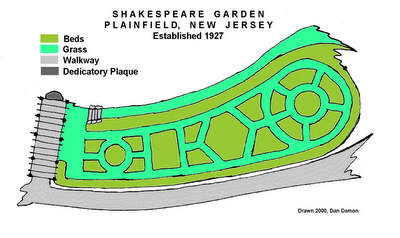Traditionally, Plainfield's Shakespeare Garden in Cedar Brook Park is seen in its best light during the first week or two of June. One of about one hundred such gardens worldwide, the Plainfield garden is a project of, and maintained by, the Plainfield Garden Club.
The following is a brief history of Plainfield's Shakespeare Garden.
HISTORY OF PLAINFIELD'S SHAKESPEARE GARDEN
The Shakespeare Garden, initiated by Mr. Howard C. Fleming of the Plainfield Shakespeare Society in 1927, and planted by [the Plainfield Garden Club], was originally meant to be but a small garden in a corner of Cedar Brook Park.

Plaque in pergola
However, the Park Commission was more ambitious and hired the Olmsted Brothers of Boston, landscape architects [the firm which designed Central Park, and Brooklyn's Prospect Park], who laid out two beds, each one hundred feet long, plus seventeen flower beds. When our members saw these yawning stretches of bare earth, they exclaimed, "How will we ever fill them?"
Plan of Plainfield's Shakespeare Garden, designed by the Olmsted Brothers firm,
famous for planning Central Park and Brooklyn's Prospect Park
famous for planning Central Park and Brooklyn's Prospect Park
Fill them they did, under the expert guidance of Mrs. Samuel T. [Annie Burnham] Carter, Jr., who remained chairman for at least eighteen years. Only about forty-four plants and shrubs are mentioned in the Bard's writings, so other material from the sixteenth and seventeenth centuries were used.
The beds, all laid out geometrically, were edged with brick, according to the custom of the times. To give the garden literary interest, stake labels were placed in the beds with the botanical and folk names, and quotations about the flowers.
Since there were only seven or eight such gardens in the entire country, ours at once attracted admiring attention. Indeed, not many years later, it was called the second finest in the United States by a horticulturalist from the New York Botanical Gardens.
Only the old varieties of plants were used in the garden, many obtained from England. During wartime [World War II], when seeds could not be obtained, Mrs. Carter and her committee managed to keep the garden gay and fragrant with flowers which, she wrote hopefully, "cheered the war weary."
Rock garden plants were added, herbs and a rose bed of old-fashioned roses including the Rosa Damascena, the original rose of Damascus and the climbing "Maiden's Blush" which rambled over Anne Hathaway's cottage.

Dovecote with "Maiden's Blush" roses
Trees were planted, among them holly, English hawthorne, mulberry, and Taxus (yew), clipped in topiary style.
Sundials were the latest rage in England during Shakespeare's time, so our garden was given one, encircled with English ivy.
A rustic arbor was built, leading into the garden. The arbor
is shaded by a honeysuckle vine called woodbine, and bordered by wild-thyme and eglantine with its sweet fruity fragrance.
--Taken from "The Plainfield Garden Club, 1915 - 1965," by Victoria Furman.
-- Dan Damon

1 comment:
I know a bank where the wild thyme blows,
Where oxlips and the nodding violet grows,
Quite over-canopied with luscious woodbine,
With sweet musk-roses and with eglantine:
(from A Midsummer Night's Dream)
Very interesting history.
Post a Comment